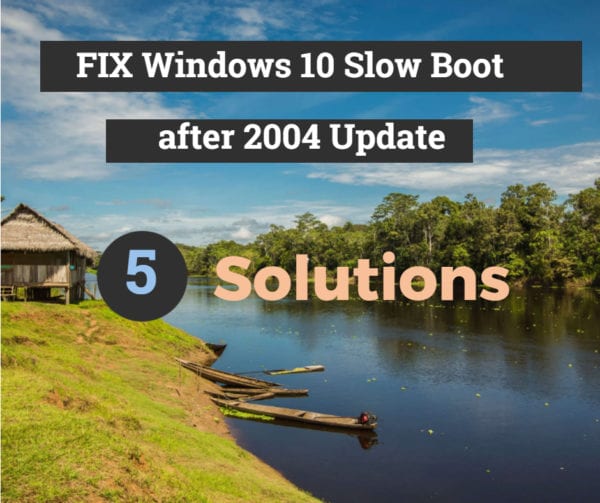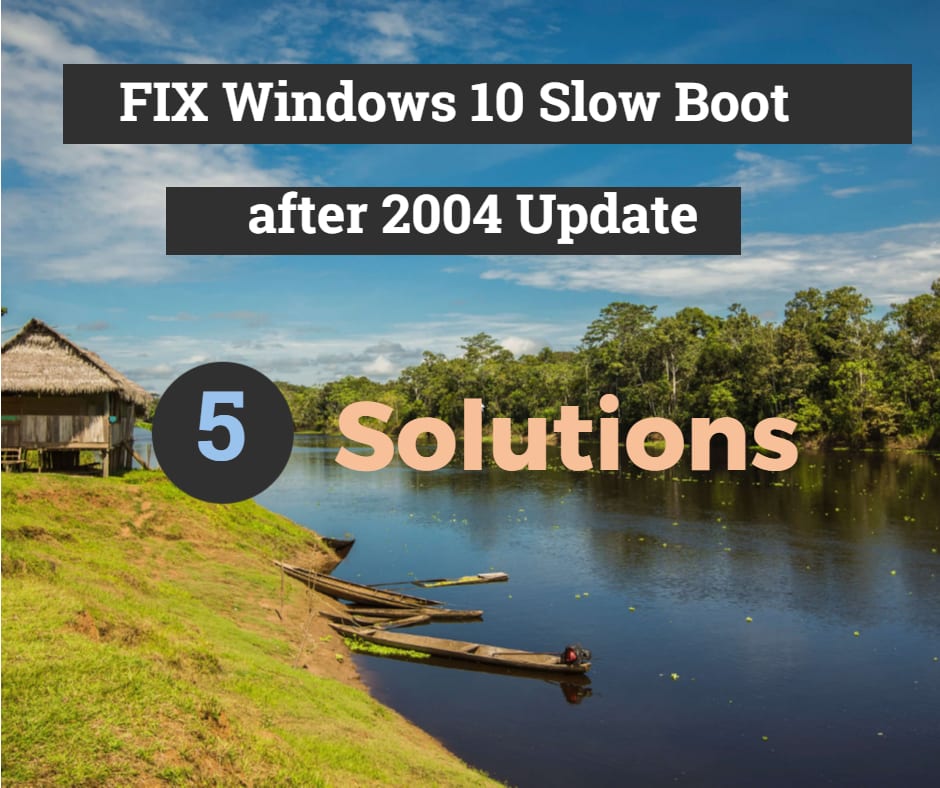Home/ Windows10/ Fix Windows10Slow Boot after Update2004– Some Solutions
How to make Windows 10 boot quicker? As a significant repair, you can disable the “ SysMain ” as well as” Windows Search ” solutions as a very first tool. Start-up things, old equipment, as well as solutions can likewise be the root cause of sluggish boot. Straightforward tweaks like disabling some solutions as well as altering to SSDcan resolve the concern.
There are various other efficiency issues after the2004 upgrade Your hard-drive can regularly rest at100% use making your laptop computer sluggish as well as pointless. Also a re-install can not resolve the issue as there can be a negative memory leakage.
Another essential adjustment you can make is to change your old HDD drives with SSD. In 2020, solid-state-drives are quick changing the typical plate drives. These increase efficiency as well as additionally boost boot time
Windows 10 Slow Boot 2020– Effect
Your Windows 10 can be extremely slow-moving as well as less competent in2020 A black display can show up when you reactivate after an upgrade.
There have actually been numerous KB updates which can trigger Windows 10 sluggish boot after upgrade2020 These consist of KB4567523, KB4538461, KB4567513, KB4532693, KB4559004 and also several others.
If you discover that your Windows 10 slow-moving after June upgrade 2020, after that it can be source of among the current KB updates after 2004 upgrade. You can uninstall that certain KB upgrade to examine if it fixes the trouble.
Internet sluggish after Windows 10 upgrade 2019 can be the source of network chauffeurs or associated problems. You can reset the network adapter or troubleshoot utilizing Windows devices.
Windows 10 sluggish after upgrade 1903 can be an additional reason for the current problem. You may not have actually observed till currently as well as this can include in your swears in2020

Luckily for me, I really did not deal with any kind of troubles with my existing arrangement. The adhering to are my specifications.
Intel Core 2 Duo Processor
Kingston 8GB DDR3 RAM
Gigabyte G41 MT-S2P motherboard
Acer P225 HQ Monitor
NVIDIA GeForce 210 graphics card
80 GB HDD, 120 GB SSD, 240 GB SSD.
SONY DVD RW
My system boots in much less than 45 secs. This can be credited to the use of SSD drive, which has actually boosted by boot efficiency.
The precise factor is not yet understood for boot problems after the 2004 upgrade. To resolve Windows 10 slow-moving after upgrade 2020, you can attempt several of these fixing actions.
Disable SysMain and also Indexing Service

In the earlier variations of Windows 10, “SysMain” solution was likewise called as SuperFetch. Since the 1809 upgrade, this is relabelled as “SysMain”. If you inspect its summary, it claims the complying with–
Maintains and also boosts system efficiency gradually.
In the first duration it took in a great deal of memory and also CPU sources. This is developed to make the most of memory and also maintain your system running efficiently also under high use of applications, applications as well as procedures.
SysMain rests silently behind-the-scenes as well as examines your RAM and also usually made use of applications, applications and also solutions. It notes these applications as “regularly made use of” as well as lots them right into RAM quicker, increasing the system efficiency.
Similarly, Indexing solution is additionally associated with “Windows Search” solution. As we understand when we include brand-new drives, folders, documents to index places, the efficiency of the computer system reduces a little. This is to make the “Search” performance of Windows 10 much more fast.
You can disable these solutions momentarily to inspect if these solutions are reducing your Windows 10 boot. If they are not, after that recover them back to their default start-up kinds. Or else, you might obtain some BSOD mistakes, if they are not the factor.
This usually occurs where the equipment arrangement of RAM, CPU and also hard-disk are of heritage kind.
Even after disabling both these solutions, your computer system still does not boot rapidly after that relocate to the following remedy.
Source: https://answers.microsoft.com/en-us/windows/forum/all/windows-booting-very-slow-after-2004- upgrade/795 f6886-8305-4555- b769- a6ca3cd7cc75? web page= 1 & auth= 1
Use an SSD for Boot, System, Page File, Active, Primary Partition
As of 2020, solid-state drive rates have actually come to be a whole lot less expensive. For $50, you can obtain a 250 GB SSD drive. It might be inadequate to save your pictures, video clip, workplace files, it is valuable to mount your Windows 10 OS.
Most motherboards sustain both SATA drives as well as SSD. You can utilize your old HDD for storage space as well as SSD for system efficiency.
For quicker accessibility too data, you can produce your OS dividing on SSD. This will certainly decrease the moment called for too up your Windows 10 computer system.
You can examine this case-study on exactly how I had the ability to minimize Windows 10 boot time utilizing SSD.

Problem with HP Laptops
In an additional online forum message, a customer bought HP Probook 450 G7 i5. The system boot extremely gradually and also obtains stuck at the HP logo design for 2 mins. It has the current setup of Intel Core i5 cpu with 8GB RAM as well as likewise an SSD.
The most recent 2004 upgrade is mounted on Windows 10 64 little bit variation. All the motorists were upgraded in addition to the BIOS. For this sort of trouble, the customer has actually allowed Fast setting in BIOS for quicker boot.
Then the sluggish boot trouble is fixed. It takes just 10 to 15 secs when Fast setting is made it possible for. Relying on your BIOS arrangement, you require to allow this each time which might be a time consuming procedure.
Source: https:// h30434 www3.hp.com/ t5/Notebook-Operating-System- and-Recovery/HP-Probook-Slow- Boot-UP/m-p/7649826 #M592040
Disable Nahimic Service
As we understand, audio innovation sets up various vehicle drivers as well as solutions. Nahimic sound software application is an HD sound modern technology which enhances sound and also voice efficiency of your video gaming system. In one situation it was discovered that Nahimic solution was the factor for sluggish starting after the 2004 upgrade.
Just like Realtek, VIA, Nvidia, this sound likewise mounts a solution in Windows10 Both ASUS and also MSI utilize its drives for improving earphones. If you are utilizing an ASUS motherboard or laptop computer, it is far better to inspect its solutions.
If you discover that your laptop computer is starting sluggish after the upgrade, you can disable the Nahimic solution. Reactivate as well as examine the boot time. If it works out, you can maintain it handicapped till the problem is fixed. Up until after that you can utilize the common chauffeurs offered by Microsoft or sustained audio codec chauffeurs by your motherboard producer.
Source: https://www.reddit.com/r/Windows10/ comments/guvzwx/applications _ launch_really_slow_after _2004 _ upgrade/
Check your Drivers
Your system includes various equipment like earphones, audio speakers, web cam, printers, hard disk, motherboard, CD/DVD drives, key-boards, displays, network adapters as well as numerous others. Several of them prepare to mount as well as plug-n-play.
You can open up Device Manager from Control Panel or Windows 10 search. Examine if there are any type of yellow exclamation marks close to any type of tools. Some gadgets are not effectively set up.
These take advantage of common vehicle drivers of Microsoft and also do not create much problem. Some tradition tools like old web cam, bluetooth tools need their very own vehicle drivers provided by its supplier. Often these are not upgraded by third-party suppliers to be suitable with Windows 10 2004 upgrade.
In such instances, utilize a chauffeur that functioned most lately. You can additionally rollback to previous vehicle drivers, if the current motorists are not functioning. This occurs primarily with visuals and also audio motorists as well as solutions.
Check your Services
You can likewise kind services.msc in the Run dialog box to open up the Services home window. By default, a number of solutions keep up Windows10 If you discover any kind of solutions unconnected to Windows 10, you can momentarily disable them.
Then inspect your boot time and also locate the perpetrator that is triggering the concern. You can disable it, till a solution is launched by the supplier or Microsoft. You can additionally attempt tidy boot to inspect if any kind of solution is the problem.
Disable StartUp Items
Sometimes a great deal of start-up things are set up when an application or program obtains set up. If you are utilizing a 2GB RAM and also an old HDD, this can badly affect boot efficiency.
The finest approach is to disable all these start-up products and also examine your boot time. If it obtains lowered, after that you can allow every one of them once more individually. If the start-up thing is the wrongdoer of slow-moving boot, after that you can disable that certain start-up application or application.
Disable Startup Tasks
If you examine your Task Scheduler after that a great deal of jobs are launched at the start-up. This consists of Google and also Adobe upgrade job programs. When you reactivate your computer system daily, these likewise might start-up everyday or once a week based upon the configuration.
In such instances, you can erase these jobs if they are not called for. This will certainly boost your boot rate as well as likewise efficiency.
This YouTube video clip talks as a whole on exactly how to correct sluggish boot problems in Windows10 It uses to 2004 upgrade. There are great deal of tweaks as well as ideas that can be put on all updates.
Conclusion
Windows 10 sluggish after upgrade 1909 suggests you require to transform your equipment. Because this is an old upgrade which was launched in October 2019, you must be excellent to go.
If you locate that your system started usually prior to as well as had issues just after the current 2004 upgrade, after that you can curtail to your old variation.
Computer slow-moving after Windows upgrade 2020 is an indicator that you have a poor vehicle driver or old HDD.
For me, I still have my SysMain as well as Indexing solutions still running. Disabling them triggered blue display mistake, so recovered the previous setups. Everything relies on your present system setup.
If disabling these solutions boosts your boot time, after that maintain it like that. Or else, return to your old setups.

